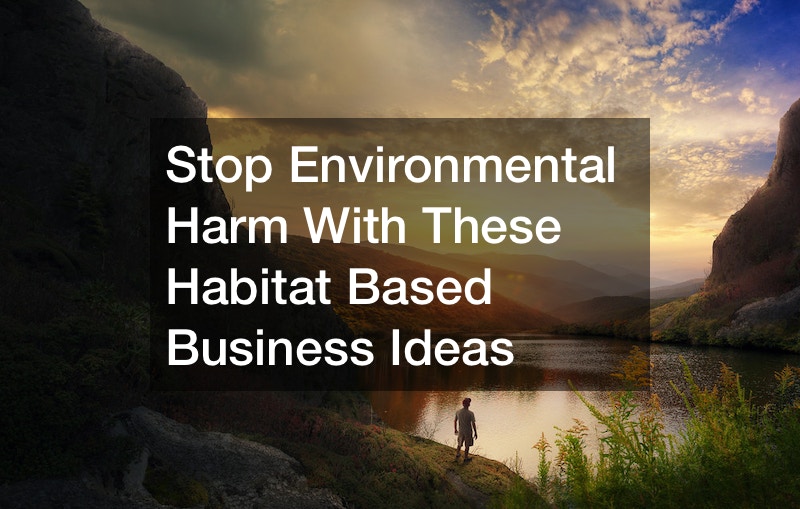Stop Environmental Harm With These Habitat Based Business Ideas

Climate change discussion is rife in human development topics. The temperatures are rising, and the need to curb pollution is more important than ever. Picture this: No clean air, no safe water to drink or edible fish due to the toxic pollution of the water bodies, no animal habitat due to heavy deforestation; the result is an apocalyptic setting we see only in movies!
While it’s true that significant environmental harm is due to businesses, does it make sense to profit at the expense of the environment? To be a climate change champion, you must stop environmental harm with the habitat-based business ideas highlighted in this article. Keep reading for a cleaner and safer world for your future generations.
Work on Air Quality

According to the World Health Organisation, in 2020, nearly 3.2 million people succumbed to household air pollution. So, how about enhancing air quality at your business premises to stop environmental harm? Begin by testing for indoor air quality.
An air test measures humidity (necessary to avoid molding), air temperature, carbon dioxide, oxygen, dew point, wet bulb temperature, chemical pollutants, and other essential air elements. The data help make environmentally conscious decisions that guarantee safety. If you don’t have access to an indoor air quality meter, you can always hire an air quality environmental company for an accurate air quality service.
An easy way to improve indoor air is to clean your workplace. A clean indoor environment has low levels of dust, mold, allergens, and other contaminants that can quickly spread through the air. Also, ensure the use of eco-friendly cleaning products with zero environmental harm. Formaldehyde, sulfates, and ammonia are toxic and cause problems like skin irritation and serious issues like fatal shortness of breath.
Take advantage of natural solutions like planting trees. According to the Arbor Day Foundation, a mature tree absorbs more than 48 pounds of carbon dioxide annually and releases oxygen into the atmosphere. Don’t forget to change your HVAC’s air filters often to avoid dust and other air pollutants from returning to your indoor air.
Keep Water Safe

Do you have access to clean water on your business premises? If yes, you may think water problems are behind you. However, according to National Geographic, only 2.5% of water globally is fresh (fit for human consumption)! Therefore, all businesses must keep water safe to sustain life and avoid environmental harm.
Without a doubt, education is the number one weapon you can use to keep water safe. As more people become aware of the global water crisis, they’ll take water conservation more seriously. You can start by sending a company-wide email to explain why water conservation is essential. Sticking attractive signs in the restrooms to remind employees to close taps after soaping their hands will also get the job done. You can also opt for reusable glass or stainless steel water bottles to discourage the use of plastic.
Perhaps you have invested in well pumping for continuous water supply. Go a step further and adopt water recycling measures. For example, water from industrial uses, such as heating and cooling, tends to have fewer contaminants. Therefore, you can easily reuse it for irrigation, PH adjustment, washing, and fire protection.
So, whether you depend on water or from the state government, you need to clean and purify water. Nowadays, you can find machine that commingle cleaning and water dispensing. You can also use water purification substances. Initially, chlorine was a widely accepted water purifier. However, the EPA raised an alarm about the negative effects of the chemical. Currently, copper ionization is the most effective for producing healthy water. Rest assured there won’t be a residual chemical that causes skin and eye irritation.
Study Pesticides
You must study pesticides and endocrine disruptors to understand why, in 2009, the EU Commission, Parliament, and Council concluded that people and our ecosystems must never be exposed to endocrine-disrupting pesticides. To save you the trouble, these chemicals potentially cause environmental harm and long-term and irreparable effects to humans, such as cancer and brain and developmental damage to unborn children, only on low ecological exposure. In fact, the council is on the verge of banning endocrine-disrupting pesticides (EDP) in 2023 after much delay.
Although pesticides are essential to control pest infestation, you must take considerable measures to avoid or reduce possible environmental harm. Pesticide formulation can easily cause leaching and runoff. For instance, wettable powder formulations will likely wash off during the rainy season than emulsified concentrate formulations.
Pesticide application timing and method are also essential. For example, some spraying techniques, such as spot treatment, are better than broadcast spray. Effectiveness mainly varies with the population of the pest and growth stage.
You should select a pesticide depending on the soil type and whether the groundwater nears the surface. For example, using a pesticide with a low leaching characteristic for sandy soil is best. Prioritize proper care and disposal when handling the chemicals and ensure you use the best pesticides for your pest problem.
Pay Attention to Landscaping and Gardens

Green landscaping and gardening are becoming popular for businesses that want to be environmentally friendly, and for good reasons. The process aims to enhance sustainability in landscaping while taking considerations to reduce negative environmental impact. For starters, consider using native plants and eco-friendly sustainable materials. Also, invest in landscaping features like permeable paving and rain gardens to minimize negative environmental impact through runoffs.
Green landscaping efforts will amount to naught if your plants grow on poor soil. In this case, the simple solution is contacting a trusted top soil provider to deliver quality topsoil for your project. Also, mulch in your yard to reduce weed growth, prevent soil erosion, and retain moisture in the soil. Mulch, albeit overlooked, is an incredible decorative element in your landscape.
In the environment conservation spirit, use products from recycled materials, like composite decking or recycled plastic landscape edging from recycled plastic lumber. Lastly, avoid using harmful herbicides and pesticides, use organic fertilizers, and, if you can, consider using other landscaping practices like xeriscaping.
Learn About Environmental Fabrics
Environmental fabric manufacture uses environmentally friendly processes, such as non-toxic dyes and finishes, to minimize any negative environmental impact on the planet. Whether your company is in the furniture or fashion industry and uses fabric to develop its products, learning about environmental fabrics is the first step to becoming an environmental champion. You must switch to environmental fabrics immediately to avoid contributing to more environmental harm. If you’re in the construction industry, consider learning and changing to geotextiles; your environment depends on it.
Switching to environmental fabrics keeps the environment clean and safe for everyone. Primarily, factories that manufacture such fabrics must focus on processes with less environmental impact. For example, you should use natural fibers, reduce energy and water consumption, and avoid toxic chemicals to conserve resources and protect the ecosystem by minimizing pollution.
Environmental fabrics are often free from materials such as synthetic dyes, chemical finishes, and pesticides that can easily cause environmental harm. As a result, they’ll minimize the chances of getting skin irritations, allergies, and other symptoms caused by contact with toxic substances.
Keep the Earth Clean
According to Development Aid, our planet will become home to nearly 2.01 billion tons of municipal solid waste (MSW) in a year. Worse, in 30 years, the figure will reach 3.40 billion! The first step to effective garbage removal and cleaning our planet is never to send garbage to landfills.
Ensure your business creates less garbage. For instance, the company must consider using ceramic and real glass alternatives instead of disposable plates, cups, and utensils. Instead of structurally intact boxes, the company can reuse them. In the offices, the company must encourage employees to maximize the use of both sides of the printing paper to minimize garbage piling.
If reusing isn’t possible, your company must consider recycling. The good news is that most cities have bins for recycling purposes. As a result, it becomes easier for companies and employees to join the noble cause. Consider using sustainable products. For instance, manufacturing products, such as print paper or cleaning products, harm the environment. So, ensure you use products in pre-consumer waste. Also, use green cleaners without toxic chemicals harmful to the environment.
Learn to Survey Land
Did you know land survey skills can help you protect the environment? How, you wonder? For beginners, it will help you know how to use land according to its suitability. For instance, you’ll farm where land is ideal for farming and develop where it’s suitable for development.
You’ll also understand the land’s topography, hydrological features, and soil quality. This information will help your company make critical decisions to avoid environmental harm. For instance, topography information on the land will help you avoid disrupting how water flows naturally and prevent you from destroying sensitive ecosystems.
Surveying land also comes in handy during conservation planning. For instance, you’ll quickly identify and map out essential natural features, such as forests, wetlands, and wildlife habitats. Therefore, you’ll know areas your company must protect or restore. Moreover, by understanding the ecological value of land, your business will avoid blunders such as putting a structure on a wetland. You’ll know the measures to take to protect the natural habitat for wildlife and protect forests.
Additionally, surveying land is vital in assessing potential environmental impact on the surrounding environment. So, data from the existing condition of the vegetation, wildlife populations, and water bodies will give information on whether your company’s operations are affecting the habitat in any way. Consider working with a seasoned land surveyor to get the job right the first time.
Study Rocks and Soil

Before starting a business, you must understand geology and petrology – study rocks and soil if you’re serious about protecting your environment. For instance, geological information will help you determine the ideal area to set up your business structure. You risk building a business in a water catchment area without proper rock and soil assessment. As a result, your project may contaminate water that people use daily.
Studying rocks and soil also helps you identify areas prone to landslides. It arms you with information to prevent losses and the risk of employee deaths due to a landslide. You’ll understand the hydrological cycle and the aquifer recharge zones where you may intend to build your business. As a result, you’ll be able to understand whether the structure will affect the environment or you’ll have to build it elsewhere.
Besides assessing rocks and soil, radon testing will also help to detect the presence of radon gas in your environment. Before putting up your building, you should understand that prolonged exposure to radon gas for a long time can cause lung cancer. For this reason, to keep everyone safe, you must conduct all the necessary tests to ensure that your business building’s location is safe.
Protect the Trees
Trees are life – it’s not even debatable. According to TreePeople, an acre of mature trees can easily produce enough oxygen to sustain 18 people in a year! For this reason, businesses must create initiatives to protect trees.
Top-of-the-class businesses understand the impact of cutting down trees. It’s now common to see lumber mills participating heavily in reforestation campaigns. Most companies will offset the environmental impact caused by their businesses by planting trees or financing other forms of habitat restoration.
As a business, you must understand that cutting down trees has adverse environmental impacts. So, if you must cut down a tree, replace it with a tree seedling. But, if you can keep the tree, keep it by all means and use your resources to protect it. Trees in your work environment provide a conducive working environment for your employees by providing fresh oxygen and shade. What’s more, trees attract birds, and bird watching is therapeutic.
To be a climatic change champion, your company must do whatever it takes to minimize or prevent environmental harm due to business operations. It will help plant trees actively, minimize pollution, and support noble climatic causes. If you want to learn more about how your business can protect the environment, please visit our website for tips and valuable insights.


